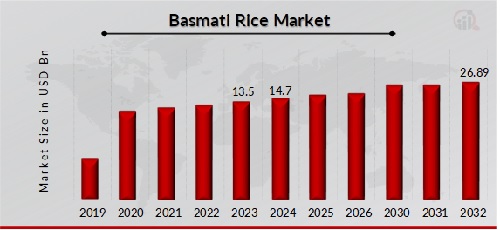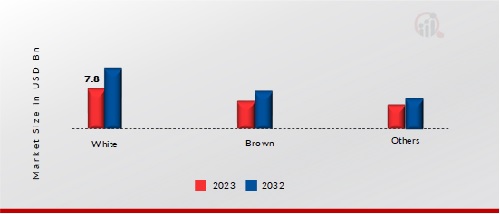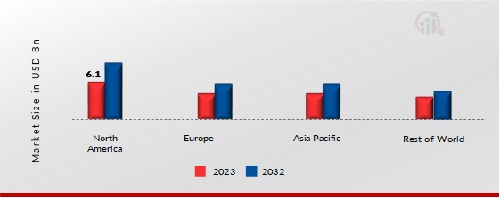Global Basmati Rice Market Overview
Basmati Rice Market Size was valued at USD 13.5 Billion in 2023. The Basmati Rice industry is projected to grow from USD 14.7 Billion in 2024 to USD 26.89 Billion by 2032, exhibiting a compound annual growth rate (CAGR) of 9.00% during the forecast period (2024 - 2032). The Growing research for the development of high-yielding varieties of basmati rice, the rise in appetite for long-grain rice, and the rise in consciousness regarding a healthy life are expected to be significant market drivers for the market of basmati rice.

Source: Secondary Research, Primary Research, MRFR Database and Analyst Review
Basmati Rice Market Trends
- Growing demand for aromatic and high-quality basmati rice is driving market growth
Market CAGR for Basmati Rice is driven by the growing demand for aromatic and high-quality basmati rice. Basmati variety Rice is vulnerable to most insect pests and diseases that can result in low productiveness and quality. The research institutes have developed several aromatic rice varieties to fulfill the increasing demand for better-quality basmati rice. In 2022, the Indian Agricultural Research Institute (IARI) came out with basmati varieties - PB1847, PB1885, and PB1886, which can fight against bacterial blight and blast diseases. As per the EU Agricultural Outlook 2020-2030, the demand for rice imports will move upwards until 2030 in this part of the world. India has exported about 3.5 billion U.S. dollars’ worth of basmati rice during fiscal year 2022. On the other hand, rice varieties other than the Basmati amounted to over $6 billion in export value that year. The paddy acreages in Uttar Pradesh are supposed to be estimated as 15,770 thousand hectares, whereas the share of Basmati Varieties stands at 461.74 thousand hectares.
With demographic growth and lifestyle changes on an international scale, people are more interested in consuming high-quality food products from premium food suppliers around the globe. The EU basmati rice import volume jumped by 70% in 2020-21 compared to the situation before the coronavirus pandemic, according to a report by Tridge. In this regard, India has also been a source to the EU, in particular, as it imported a total of 231,930 Metric Tons of Basmati Rice from April 2020 to November 2020. The increasing need for high-quality aromatic rice ultimately promotes market devolvement. As a result, it is anticipated that throughout the projection period, demand for the Basmati Rice Market will increase due to the growing demand for aromatic and high-quality basmati rice. Thus, driving the basmati rice industry revenue.
Segment Insights
Basmati Rice Type Insights
The Basmati Rice Market segmentation, based on Type, includes Parboiled and Raw. The parboiled segment dominated the market, accounting for 58% of market revenue. Parboiling also provides a longer shelf life to rice as the oils in the bran layer are set at an equilibrium. This leads to improved freshness of the rice, allowing it to be stored for a longer time without compromising its quality. Consequently, the parboiling of Basmati rice yields a longer shelf life that is highly valued by both the food retailers and the customers.
Basmati Rice Species Insights
The Basmati Rice Market segmentation, based on Species, includes White, Brown, and Others. The white segment dominated the market, accounting for 58% of market revenue. White Basmati rice offers visual delight with its long grains and cottony white color. Consumers commonly choose this form because it is visually pleasing. White basmati is traditionally considered a healthier analog of other kinds of white rice because of its lower glycemic index and higher nutritional value. With the growing health awareness coupled with the desire for nutritious meal options, the demand for white Basmati rice is expected to increase over the years.
Figure 1: Basmati Rice Market, by Species, 2023 & 2032 (USD Billion)

Source: Secondary Research, Primary Research, MRFR Database and Analyst Review
Basmati Rice Pack Size Insights
The Basmati Rice Market segmentation, based on Pack Size, includes Retail Packaging and Institutional Packaging. The retail packaging segment dominated the market, accounting for 60% of market revenue. Retail packaging provides convenience to consumers by offering pre-packaged quantities of Basmati rice, which are easy to handle and store. The trend towards packaged products is driven by their ease of use and the assurance of quality they provide. Additionally, retail packaging often incorporates features like vacuum sealing or nitrogen flushing, which prolong the shelf life of Basmati rice. This aspect appeals to consumers who prefer to stock up on staple foods for extended periods without concerns about spoilage.
Basmati Rice End-Use Insights
The Basmati Rice Market segmentation, based on End Use, includes Industrial and Household. The industrial segment dominated the market, accounting for 60% of market revenue. The processed food industry resorts to Basmati rice as one of the main ingredients in the production of packaged foods and snacks. The growing scale of the food processing sector on the global level entails that more basmati rice is being consumed to produce snacks, instant meals, and processed rice products.
Basmati Rice Distribution Channel Insights
The Basmati Rice Market segmentation, based on Distribution Channels, includes Traditional, Modern, Retail, and HORECA. The retail segment dominated the market, accounting for 60% of market revenue. The commercialization of quality rice has been made possible through the marketing of numerous Basmati rice products by retailers to meet consumers' tastes. It comprises various types of grains, such as long or short, organic options, flavored mixtures, and specialty blends. Furthermore, attractive and convenient packaging options such as resealable pouches, zip-lock bags, and vacuum-sealed packs have added much value to the sale of products in the retail segment.
Regional Insights
By region, the study provides market insights into North America, Europe, Asia-Pacific, and the Rest of the World. The anticipated expansion of the Basmati Rice market in North America can be attributed to several key factors. Basmati rice availability in North America has vividly increased over the years compared to the past. It becomes more accessible to consumers in major retail grocery stores, specialty food markets, and online platforms, making buying and consumption a simpler task. In the 2022/23 marketing year (August–July), U.S. rice imports are forecasted to grow by 16 percent compared to the previous year and hit their highest levels on record with 44 million hundredweight.
Further, the major countries studied in the market report are the US, Canada, Germany, France, the UK, Italy, Spain, China, Japan, India, Australia, South Korea, and Brazil.
Figure 2: BASMATI RICE MARKET SHARE BY REGION 2023 (USD Billion)

Source: Secondary Research, Primary Research, MRFR Database and Analyst Review
Europe's Basmati Rice Market accounts for the second-largest market share as Basmati rice is perceived by some as a healthier choice rather than regular white rice. More than two-thirds (67.8 %) of persons in the EU have perceived their health as very good or good, as compared to 2022 reports. In terms of the EU Member States, Germany and France had the highest healthcare expenditures compared to GDP, which was 12.8% and 12.2%, respectively, in 2020. It has a low glycemic index, and hence, the gradual release of sugar in the body. This type of sweetener is, therefore, suitable for people who are watching their carbohydrate intake and for people suffering from diabetes. Moreover, Basmati rice is gluten-free and naturally low in fat, which also targets customers with health concerns. Further, the German basmati rice industry held the largest market share, and the UK Basmati Rice was the fastest-growing market in the European region
The Asia-Pacific Basmati Rice Market is expected to grow at the fastest CAGR from 2024 to 2032. The growing acceptance of basmati rice in the food and drink sector to create numerous traditional Indian meals such as biryani, desserts, pilafs, etc., is also responsible for the market expansion. In the 2023 year, the exports of basmati have reached Rs 18310.35 crore, with the country exporting a quantity of 20.10 lakh metric tonnes. For the same period in 2022-23, the basmati rice exports amounted to the amount of Rupees 15,4514.74 crore with the shipping of 18.75 LMT. Again, in 2021-22, the Indian export of basmati rice garnered Rs 10,690.03 crore, where the quantity exported was 17.02 LMT. Moreover, China’s Basmati Rice held the largest market share, and the Indian basmati rice industry was the fastest-growing market in the Asia-Pacific region.
Basmati Rice Key Market Players & Competitive Insights
Leading market players are investing heavily in research and development to expand their product lines, which will help the Basmati Rice market, grow even more. Market participants are also undertaking a variety of strategic activities to expand their global footprint, with important market developments including new product launches, contractual agreements, mergers and acquisitions, higher investments, and collaboration with other organizations. To expand and survive in a more competitive and rising market climate, the Basmati Rice industry must offer cost-effective items.
Manufacturing locally to minimize operational costs is one of the key business tactics used by manufacturers in the global Basmati Rice industry to benefit clients and increase the market sector. In recent years, the Basmati Rice industry has offered some of the most significant advantages to the food industry, including premium quality, distinctive flavor, and cultural significance in various cuisines. Major players in the Basmati Rice Market, including Adani Wilmar Ltd, ITC, East End Foods, TBA Suntra, Amira Basmati Rice, VSR Rice, The Rice 'n, Spice International Ltd., Kohinoor Foods, S.G.S. International Rice Company., LT Foods is attempting to increase market demand by investing in research and development operations.
Adani Wilmar Limited is a subsidiary of Adani Group that specializes in consumer-branded goods (FMCG). The company develops consumable items for the Indian market, such as edible oil, wheat flour, rice, pulses, and sugar. Similarly, it has a consumer health and convenience brand portfolio consisting of Rice Bran oil, blended oil, soya nuggets, buffalo meat, rhyme kit, and khichdi. Their segments include Edible Oils, Food & FMCG, as well as Industry Essentials. The Horeca business Oil segment includes buying and processing of oil. The Food & FMCG segment is responsible for purchasing and producing food items for consumption. The Industry Essentials segment is focused on the activities of commodity trading and the production of chemical products. The product portfolio, which includes versatile oleochemicals, castor oil and its derivatives, as well as de-oiled cakes, is quite extensive. It sells all of its packed products in edible oil and food FMCG segments to consumer markets under various brand names, including Fortune, Raag, Bullet, Fryola, Jubilee, Aadhar, and Kohinoor. In May 2022, Adani Wilmar Ltd purchased the 'Kohinoor' trademark from McCormick Switzerland GMBH. The acquisition would enable AWL to own the trademark of 'Kohinoor' basmati rice as well as 'Ready-to-Cook' and 'Ready-to-Eat' curries and meals, which will be marketed under the umbrella brand of Kohinoor in India.
ITC runs a diversified conglomerate business. The company is a manufacturer of fast-moving consumer goods, hotels, paperboards and specialty papers, packaging, agribusiness, and information technology. The Company develops products under the brands of tobacco and leaf, foods, personal care, stationery, safety matches, incense sticks (agarbattis), paperboards and packaging material, specialty papers, and agribusiness. The major brands are bread brands Ashirwad, SunFest, Yippee!, Bingo, Farmland, Sunrise John Players, Gold Flake, Classmate, Aim, and Superfine Printing. The organization works in The United States of America, Canada, Europe as well as the South East Asian countries. ITC has its headquarters in Kolkata, West Bengal, India.
Key companies in the Basmati Rice Market include
- Adani Wilmar Ltd
- ITC
- East End Foods
- TBA Suntra
- Amira Basmati Rice
- VSR Rice
- The Rice 'n Spice International Ltd.
- Kohinoor Foods
- G.S. International Rice Company.
- LT Foods
Basmati Rice Industry Developments
July 2020: ITC Ltd announced the purchase of spices producer Sunrise Foods Private Ltd through an all-cash transaction valued at Rs 2,150 crore. Additionally, sellers became eligible for a contingency payment of up to Rs 150 crore.
July 2019: Amira Nature Foods Ltd, a worldwide supplier of packaged Indian specialty rice, announced a contract to deliver approximately $18 million worth of third-party branded rice to a new client in the EMEA region
Basmati Rice Market Segmentation
Basmati Rice Type Outlook
Basmati Rice Species Outlook
Basmati Rice Pack Size Outlook
- Retail Packaging
- Institutional Packaging
Basmati Rice End-Use Outlook
Basmati Rice Distribution Channel Outlook
- Traditional
- Modern
- Retail
- HORECA
Basmati Rice Regional Outlook
- North America
- Europe
- Germany
- France
- UK
- Italy
- Spain
- Rest of Europe
- Asia-Pacific
- China
- Japan
- India
- Australia
- South Korea
- Rest of Asia-Pacific
- Rest of the World
- Middle East
- Africa
- Latin America
| Report Attribute/Metric |
Details |
| Market Size 2023 |
USD 13.5 Billion |
| Market Size 2024 |
USD 14.7 Billion |
| Market Size 2032 |
USD 26.89 Billion |
| Compound Annual Growth Rate (CAGR) |
9.00% (2024-2032) |
| Base Year |
2023 |
| Market Forecast Period |
2024-2032 |
| Historical Data |
2019-2022 |
| Market Forecast Units |
Value (USD Billion) |
| Report Coverage |
Revenue Forecast, Market Competitive Landscape, Growth Factors, and Trends |
| Segments Covered |
Type, Species, Pack Size, End-use, and Distribution Channels, and Region |
| Geographies Covered |
North America, Europe, Asia Pacific, and the Rest of the World |
| Countries Covered |
The US, Canada, Germany, France, UK, Italy, Spain, China, Japan, India, Australia, South Korea, and Brazil |
| Key Companies Profiled |
Adani Wilmar Ltd, ITC, East End Foods, TBA Suntra, Amira Basmati Rice, VSR Rice, The Rice 'n, Spice International Ltd., Kohinoor Foods, S.G.S. International Rice Company., LT Foods |
| Key Market Opportunities |
Introduction of favorable trade policies and licensing procedures for agricultural exports |
| Key Market Dynamics |
Increase in consumption and production of Basmati Rice |
Frequently Asked Questions (FAQ) :
The Basmati Rice Market size was valued at USD 13.5 Billion in 2023.
The Basmati Rice Market is projected to grow at a CAGR of 9.00% during the forecast period, 2024-2032.
North America had the largest share of the global market
The key players in the market are Adani Wilmar Ltd, ITC, East End Foods, TBA Suntra, Amira Basmati Rice, VSR Rice, The Rice 'n, Spice International Ltd., Kohinoor Foods, S.G.S. International Rice Company., LT Foods.
The Parboiled segment dominated the market in 2023.
The Retail segment had the largest share in the global market.

















